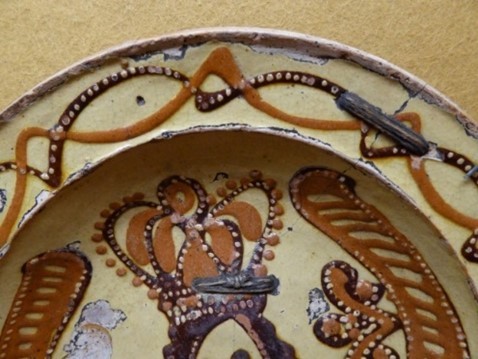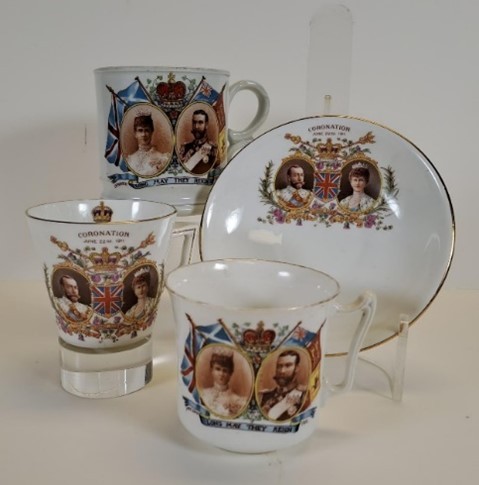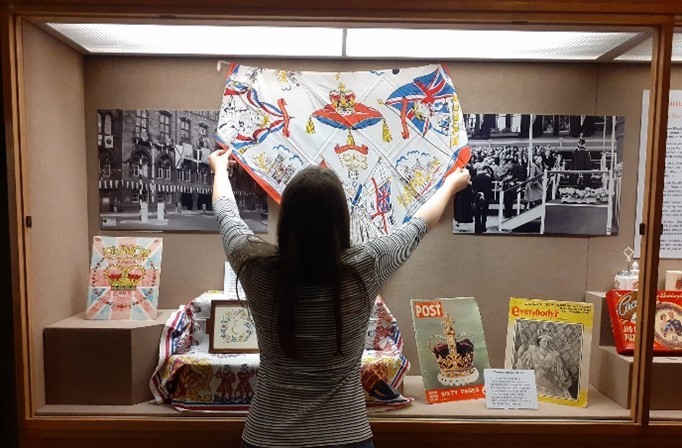To celebrate the coronation of King Charles III and Queen Camilla on Saturday 6th May 2023, members of the Collections Team have shared some coronation-related items in Bradford District Museums and Galleries’ collection, from ostentatious objects to coronation kitsch.
Crown chairs
One of our Assistant Curators, Dr Lauren Padgett, chose the 17th-century ‘crown chairs’.
On display at Bolling Hall Museum, these chairs date to the Restoration period (1660-88). How can we tell? The crest and foot rails are adorned with carved crowns.


This crown motif symbolised the end of England being ruled by a Republican government with no monarchy (from 1649 to 1660) and the restoration of the monarchy when Charles II returned from exile in 1660 and was officially crowned King in 1661.
Furniture made during King Charles II’s reign (1660-85) typically has the crown with cherubs (putti) while furniture made during King James II’s reign (1685-88) is more likely to have leaves accompanying the crown instead.


Repaired plate
One of Registrar Pamela Keeton’s favourite collection objects is the glorious slip trailed plate created to celebrate the restoration of the monarchy and coronation of King Charles II.
Currently on display at Cliffe Castle Museum, it’s the lively, exuberant ornamentation, the expression of the potter’s hand and the historic repair which fascinates her.

English decorative slip trailed ceramics were popular in the late 17th and early 18th centuries. These wares were elaborately decorated with popular motifs of the day including commemorative themes such as King Charles II and his wife Queen Catherine of Braganza.
This object’s unique feature is that it has been broken and repaired – not recently or in a manner we would recognise today. Rather than using an adhesive, the body of the ceramic has had holes pierced either side of the break and the plate has been stitched together with twine. ‘Sewing’, ‘lacing’ and riveting pieces of ceramic together with thread, twine or wire was common through the 17th to early 19th centuries and took great skill to get the edges aligned.


This plate has clearly always been a loved and highly valued belonging. It was considered worth the time and expense of being mended and this very neat, competent repair hasn’t failed the test of time.
Pam examines this unique plate in more detail in this blog: https://bradfordmuseums.org/pams-favourite-object-king-charles-ii-repaired-plate/
Parris’ painting
Pam also picked the painting ‘The Coronation of Queen Victoria’ by Edmund Thomas Parris.
This painting was borrowed by Historic Royal Palaces and restored prior to display in their exhibition ‘Victoria: A Royal Childhood’ at Kensington Palace. It depicts the Bishop of Canterbury placing the Imperial State Crown on Queen Victoria’s head, while dignitaries look on, during the coronation ceremony in Westminster Abbey in 1838.

Areas of flaking paint were consolidated and the degraded relining canvas was taken off and glue residues scraped away. The accumulated surface dirt and discoloured varnish was meticulously removed with swabs of solvent to reveal the true colours of the paint below. Areas of paint loss were in-filled before being meticulously colour matched and retouched. The final stage was a unifying layer of varnish.

Bradford District Museums and Galleries’ thanks go to paintings conservator David Everingham, Historic Royal Palaces and Friends of Bradford Art Galleries and Museums for their work and donations which allowed the painting to be restored.

Coronation cloth
Lauren singled out the sample of crimson coronation silk velvet in the designated Worsted collection.
This fabric was woven at Lister’s Mill (also known as Manningham Mills), Bradford, for the Peers’ ceremonial robes for King George V and Queen Mary’s coronation on 22nd June 1911. Lister’s Mill produced 1,000 yards of velvet for this coronation ceremony.



This photographic postcard in our collection shows Lister’s Mill lit up with illuminations for the 1911 coronation.

Several years before the coronation, as Prince and Princess of Wales, the Royal couple visited Bradford on 4th May 1904. During the visit, they attended the unveiling ceremony of the Queen Victoria statue; officially opened the Bradford Exhibition at Cartwright Memorial Hall (now Cartwright Hall Art Gallery) and in Lister Park; and visited Lister’s Mill – resulting in a subsequent order of fabric for their 1911 coronation ceremony.
Our Photo Archivist John Ashton provided these photographs from the Photo Archive, taken by C H Wood on the day of their Royal visit, showing the Queen Victoria statue ceremony and the arrival of the Prince and Princess of Wales at Cartwright Memorial Hall, respectively.


Find out more about our designated Worsted collection and Bradford’s textile heritage in this blog: https://bradfordmuseums.org/built-of-wool-worsted-collection/
Coronation ceramics
Like many museum collections around the country, Bradford District Museums and Galleries’ collection of 20th-century coronation ceramics is extensive and varied.
Some of the earliest and rarest royal coronation memorabilia dates back to the Restoration of the monarchy in 1660 and the coronation of King Charles II. However, it was not until the mid-18th century, when transfer printing onto pottery came into being, that commemorative wares could be mass produced and enjoyed by everyone.
Souvenir items were made by the largest, most prestigious ceramic producers to small, regional manufacturers and local artisans. Businesses, societies and institutions commissioned personalised pieces as celebratory gifts to loyal customers and commemorative souvenirs for employees and members.


1902 coronation of King Edward VII.

1911 coronation of King George V.



1937 coronation of King Edward VIII.

1937 coronation of King George VI.
Contemporary collecting
In 2022, Bradford District Museums and Galleries had different displays across the sites to celebrate Queen Elizabeth II’s platinum jubilee. A digital version of these past displays is still available. See some of the objects linked to Queen Elizabeth II’s coronation in 1953 and find out about her Royal visits to the Bradford District here: https://bradfordmuseums.org/platinum-record-bradford-museums-and-galleries-jubilee-displays/
As part of our collection development, we will be looking to acquire commemorative souvenirs relating to the coronation of King Charles III to continue collecting and preserving the material culture of coronations into the 21st century. What will you collect?
